biography
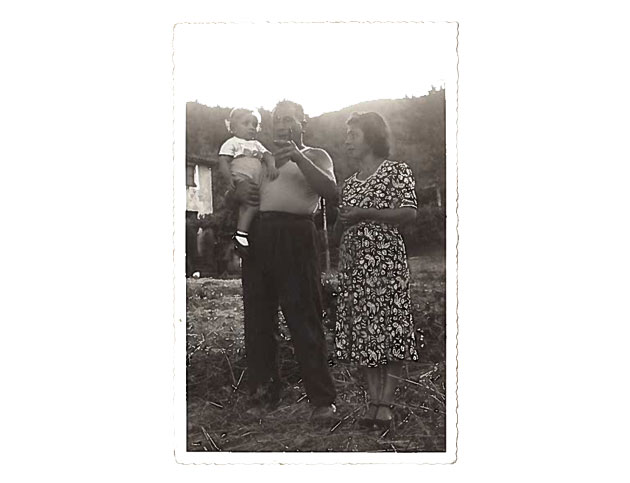
Childhood
GIUSEPPE WITH HIS PARENTS – CAIRO MONTENOTTE 1953
Giuseppe Scaiola was born in 1951 in a village in the neighbourhood of Cairo Montenotte, an industrial township in the province of Savona. His father, Mario, was a manual worker and his mother, Maria Rabino, a housewife. Right from the start Giuseppe’s parents encouraged his artistic leanings. His interest in drawing and painting manifested itself early in life and his parents approved his decision to attend the art college in Savona. Scaiola’s work reveals a personal bond existing between himself, as an artist, and his roots or origins (predominant themes are Earth, Nature and Work).
Childhood

The '70s
He was only twenty one years old when having finished his studies at Liceo A. Martini, he took up a teaching post there in 1972, although only briefly, teaching Plastic Arts. While teaching, he enrolled at the Accademia Albertina di Belle Arti in Turin and gained his diploma in 1975. Taking part in the lively contemporary arts scene in Turin, Scaiola was a frequent visitor to Turin’s galleries – above all, the galleries run by Giorgio Persano and Gian Enzo Sperone – and he befriended various artists, among whom Gilberto Zorio. His first exhibition was at the Quadriennale romana in 1975. This was followed in 1976 by an impressive one-man show at Palazzo dei Diamanti in Ferrara, where he was presented by Franco Farina. In 1977, he exhibited at the municipal gallery, Galleria Civica, in Modena. Since the beginning of his activity the patronage of the Castagneto family has helped him considerably in his artistic career. In 1979, Scaiola put on a one-man show at Milan’s Galleria Annunciata (catalogue introduction by Gillo Dorfles) and was interviewed by Ferruccio De Bortoli (“Corriere d’Informazione”). In 1980 he worked in Paris for a short time, where he completed the cycle of the paintings of the nuns. Giuseppe soon moved to Milan. A very close friend at the time – and since – was the great sculptor, Agenore Fabbri, whom he had met in the small town, Albissola.
The '70s
The early '80s
“Avant garde” gallery owners such as Franco Cicconi, from Macerata, and a number of critics expressed their interest in his work. These include Roberto Sanesi, Francesco Vincitorio and Flavio Caroli, as well as Renato Barilli who, in 1984, wrote a presentation for his exhibitions at the contemporary arts galleries in the towns, Suzzara and Malcesine. Giuseppe’s father died in 1984. This terrible loss affected Giuseppe’s later work. The figurative element disappeared. Lucio Del Gobbo perceptively noted in his work that “it is the broad field of the informal that, from scenario, evolves into a locus of research”. In 1986, these radically different pieces were exhibited at the Artra Gallery in Milan. The event of that exhibition is remembered for the purchase of all the works by the collector Salvatore Manzoni, with whom Scaiola formed a friendship and a bond of mutual esteem.
The early '80s
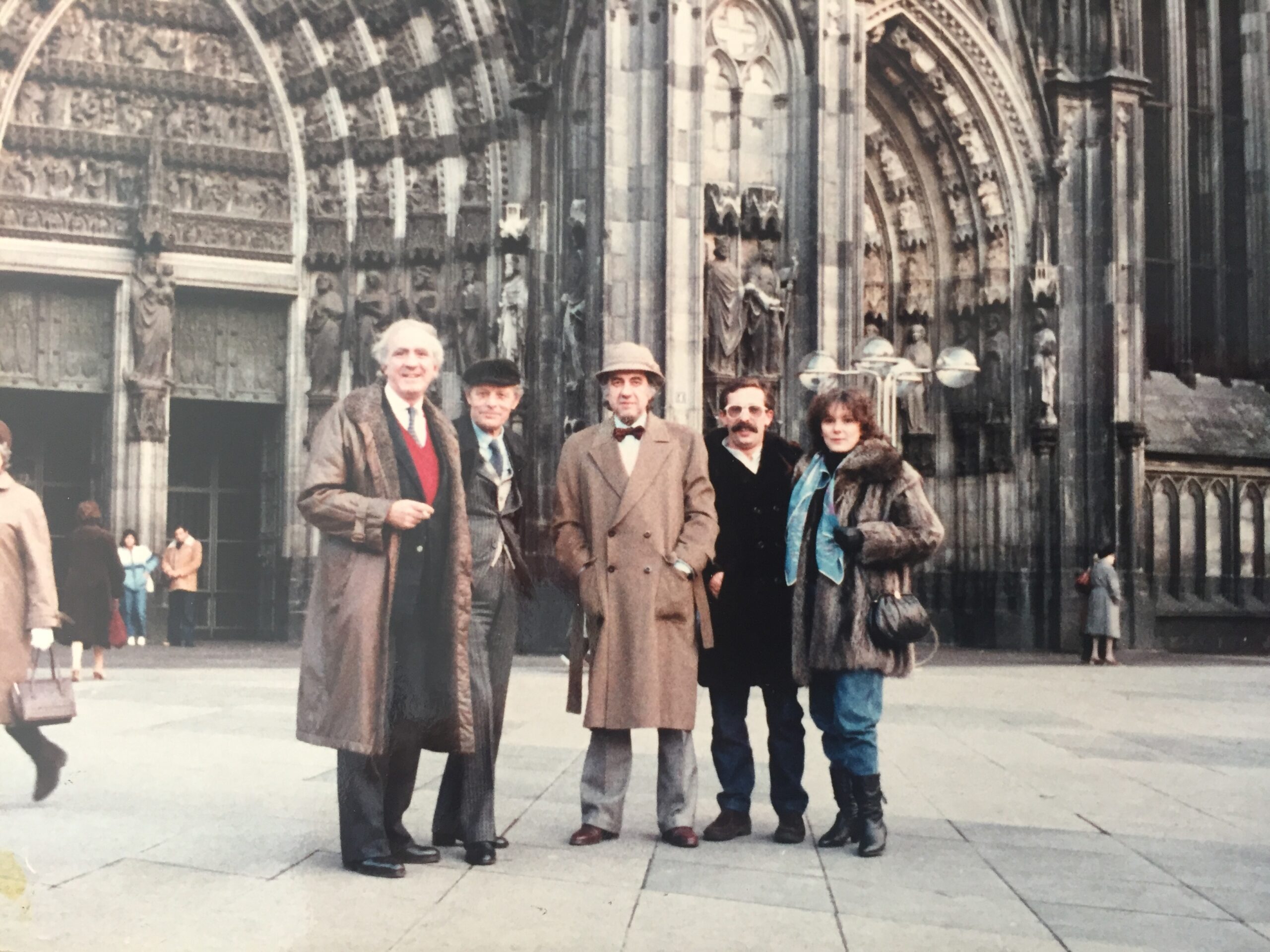
The late '80s
MARIO ROSSELLO, AGENORE FABBRI, RENATO CARDAZZO, GIUSEPPE AND GIANCARLA SCAIOLA - KOLN
Scaiola married Giancarla Pongibove in 1988. They had known each other since they were children. In the mid-eighties, Scaiola also collaborated with one of Europe’s leading silk screen printers, Rinaldo Rossi, from Genoa. Over the last few years, various limited editions of excellent quality have come out of this enduring partnership. It was during this period that Agenore Fabbri introduced Scaiola to the German collector Volker W. Feierabend who immediately took to Scaiola’s work. From this friendship started a strong interest on the part of German art collectors and museums, which eventually resulted in a wide programme of exhibitions. At the same time, the Klaus Braun Gallery in Stuttgart disseminates his work and this collaboration will continue for many years.
The late '80s
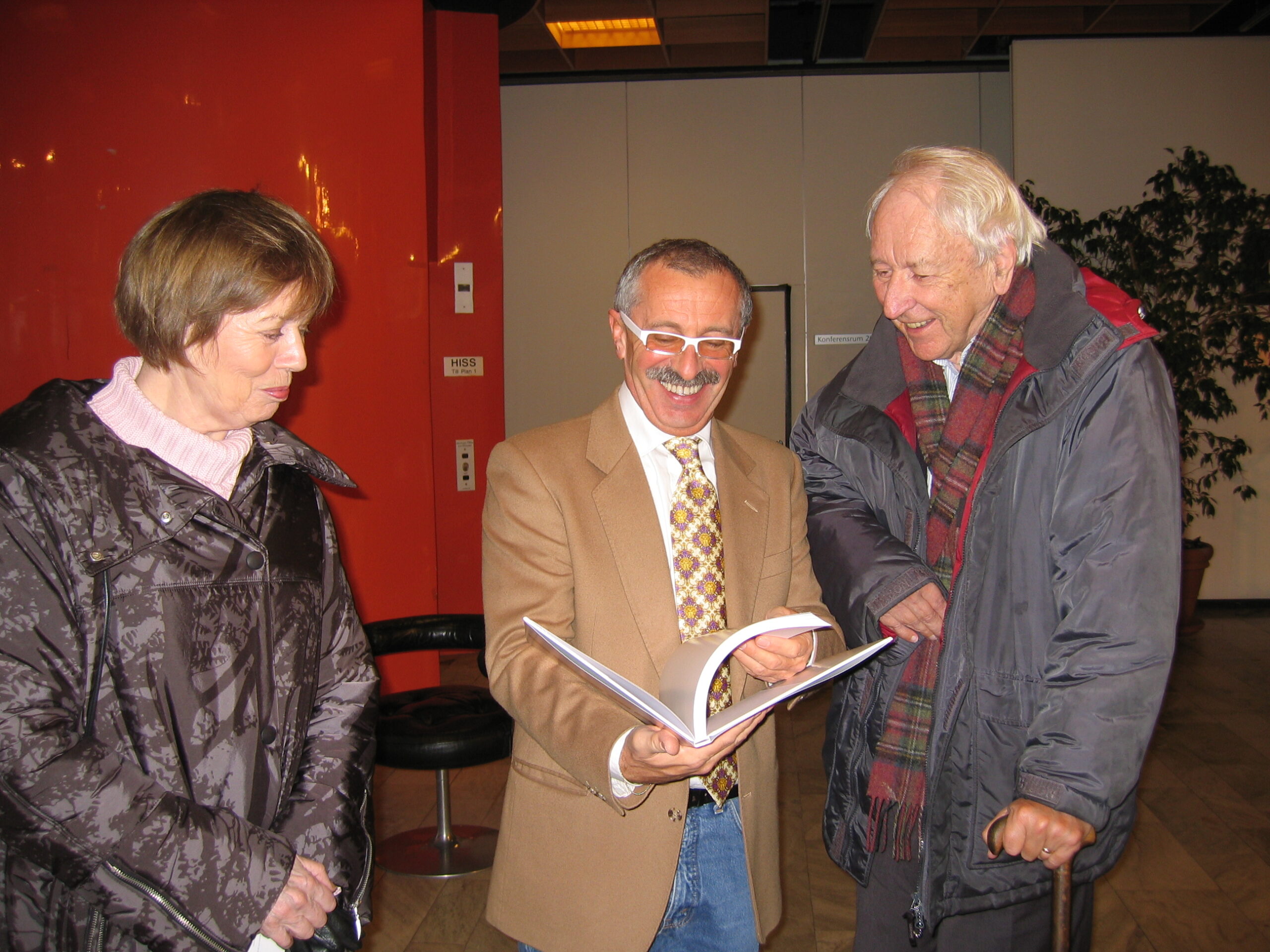
The '90s
MONICA TRANSTROMER, GIUSEPPE SCAIOLA AND THOMAS TRANSTROMER
Various operators on the scene in West Germany took an interest in his work. Important museums purchased works (the Ludwig Gallery in Cologne, the Galerie der Stadt in Stuttgart and the Kunstmuseum in Bonn). The director of the Bonn Kunstmuseum, Dieter Ronte, introduced the catalogue for various exhibitions in Germany and Italy in 1992 and 1993. At the end of 1994 Scaiola exhibited 50 works at the Kulturhistorisches Museum (Stralsund). The interest Scaiola has generated among collectors and museum managers in Germany paved the way to the many exhibitions planned there for 2004. The Stockholm gallery owner, Mats Bergman, contacted Scaiola in 2001, having discovered one of his paintings at the home of a Swedish collector, Andrè Barbro. An exhibition was organised in Stockholm in the spring of 2001 and Scaiola made a serygraph inspired by the lines of the Swedish poet Thomas Tranströmer “Memories see me”. When he came back from this trip in Sweden his beloved mother died.
The '90s

The early '00s
TAKASHI MURAKAMI AND GIUSEPPE SCAIOLA – 2000
In 2002, CIMAC – Milan’s municipal contemporary arts gallery – purchased a work by Scaiola, “Terra d’oro” (land of gold) This painting is now part of the exhibition “ BELLA PITTURA”, held at the New Museum in Weimar, at the Von der Heydt Museum in Wuppertal and at the Klagenfurt City Hall Gallery. Contractual obligations between Scaiola and Galleria Il Prisma were stipulated in 2002. The gallery also organised one-man shows at the National Museum of the History and Culture of Belarus in Minsk and at the St. Peter and Paul’s Fortress in St. Petersburg in Russia during 2003 and 2004 (catalogue presentation by art critic Aleksandr Borovskij). Meanwhile all museums have purchased one painting for their respective permanent collections.
The early '00s
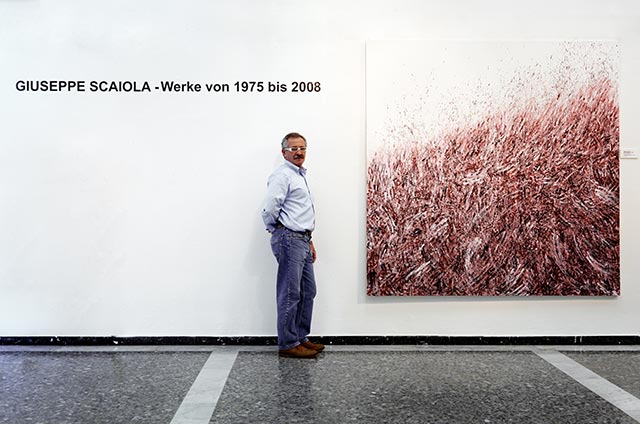
2005 - 2010
GIUSEPPE SCAIOLA – KLAGENFURT 2009
In the scope of stable cooperation relations another exhibition was organised at the Lindingö Konsthall in Stockholm. The most important event in 2006 is an exclusivity contract with the Gallery JZ Art Trading in Milan, which organizes an exhibition of his paintings in the spring of 2007. In autumn, after a short and incurable disease his adored wife died. The following year the city of Tortona organizes in the prestigious Palazzo Guidobono a personal exhibiton of his paintings, with works from 1986 to 2008. 2009 stands out for two exhibitions in Austria, one at the Alpen-Adria-Galerie in Klagenfurt and one at the White8 gallery in Villach. One part of these exhibitions has been presented at the Valente gallery , Arte Contemporanea in Finale Ligure.
2005 - 2010
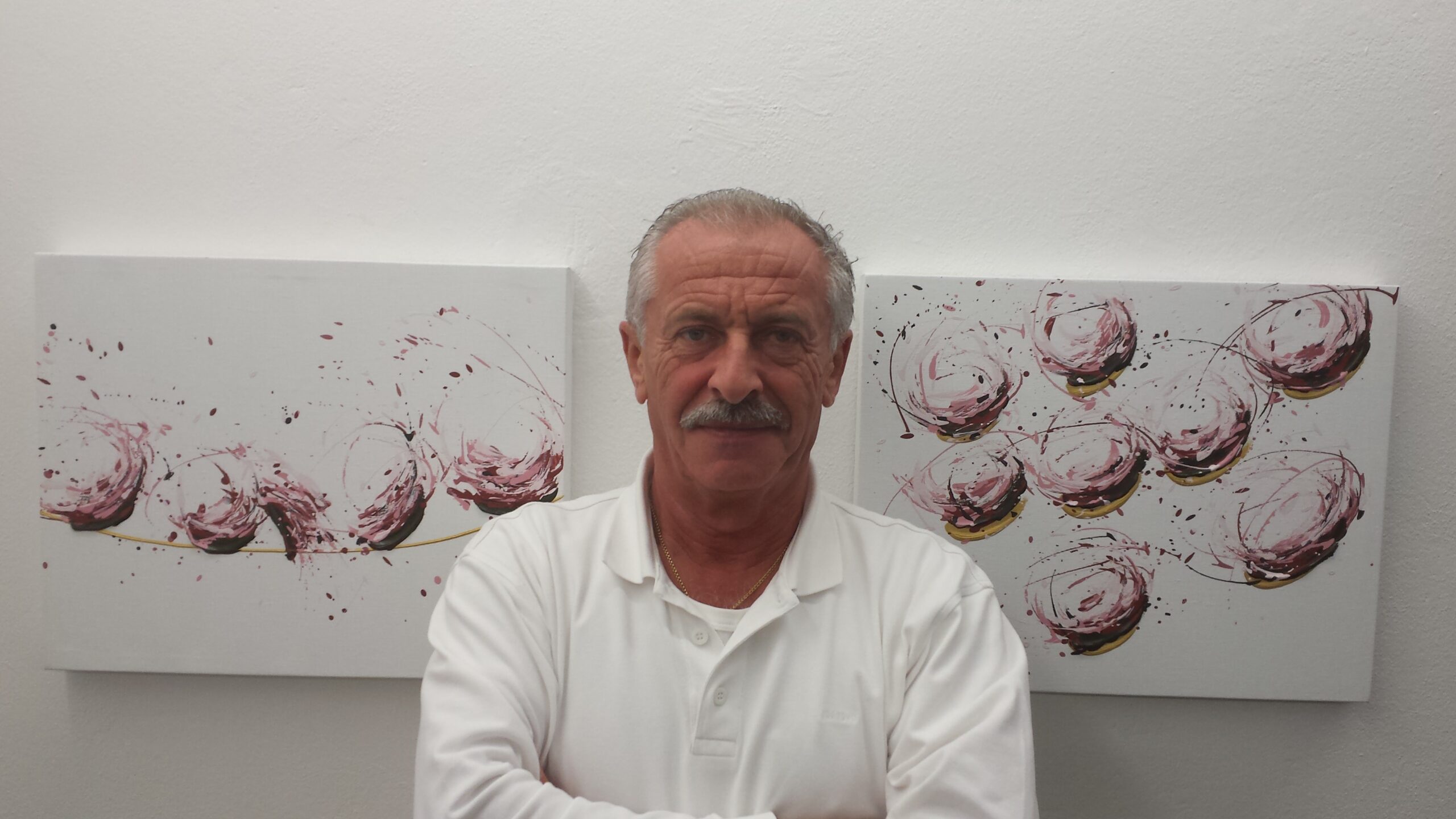
2011 - 2023
GIUSEPPE SCAIOLA - STUTTGART 2014
In recent years Scaiola has worked with galleries in Germany and Sweden.
Some paintings from this period give the idea of moving fields of grass or thorny bushes, but more important than the visible natural objects are the elemental forces that form the structure. As in the imposing fireballs of "Forma Primaria" (2018): an image of the big bang. The world of becoming shown here does not contain one thing that we can call concrete, but it carries within it the possibility of thousands of future things. Over the years, Scaiola has always remained faithful to his style in the depiction of his most beloved subject: nature. His abstract creations are projections of the geometries, rhythm and balance of nature that the artist aims to transmit to the observer, reworking them through shapes and colors transferred onto the canvas according to his very personal style.
2011 - 2023